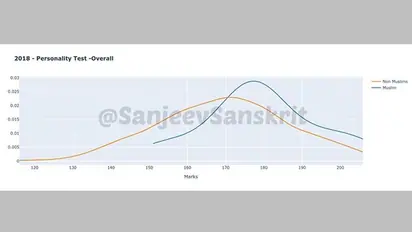
Bengaluru: There is a hue and cry over a TV show by Sudarshan TV. Many cried foul that the programme targeted Muslims in the UPSC and even approached the Supreme Court and successfully manged to bring a stay on it.
As reported by a popular website, the show - UPSC Jihad - focuses on certain very specific aspects – mainly, the undue advantage to Muslim candidates and the infiltration of problematic organisations like the Zakat Foundation, which, per the show, receives funds from terrorist organisations.
The matter is still sub-judice.
However, Sanjeev Newar, a data scientist has put out a series of tweets, explaining how Muslim aspirants have got greater marks compared to aspirants of other religions with the help of graphs.
He then talks about the written marks:
“The written marks of 2018 have more interesting pattern. M marks (blue) show perfect bell curve (actually too perfect for small sample). But non-M marks (orange) seem as if half of candidates' have marks pulled towards lower to balance for higher marks of top half of candidates.+”
After the written marks of 2018, the next observation put out is about the year 2017.
He says, “In 2017, interview marks show same trend but margin of difference between M and non-M is lesser. 2016 has a bit uneven marks pattern for non-M but a smooth curve for M. Interesting!+”
The comparison between the two:
He adds, “If we compare written marks for 2017 and 2016, they are close. I won't infer much given the sample size difference in M and non-M candidates. So instead of being too finicky, I would say they are broadly same.+”
Here’s a note on how Muslims outperformed non-Muslims every year.
“Note that this is what data shows. Why this is happening is not something data can suggest with this info. However I did plot category wise interview marks to see if story is different. But what I found was that for each of OBC and General, M still outperformed non-M every year+”
He also goes on to provide charts for written performance over the years.
“I would also provide charts for written performance over years. I leave it to people to bring out inferences. What is important though is that on average OBC non-M seem to be having biggest shortfall compared to OBC M in interviews. It was 10.07 in 2018 and 9 in 2016.”